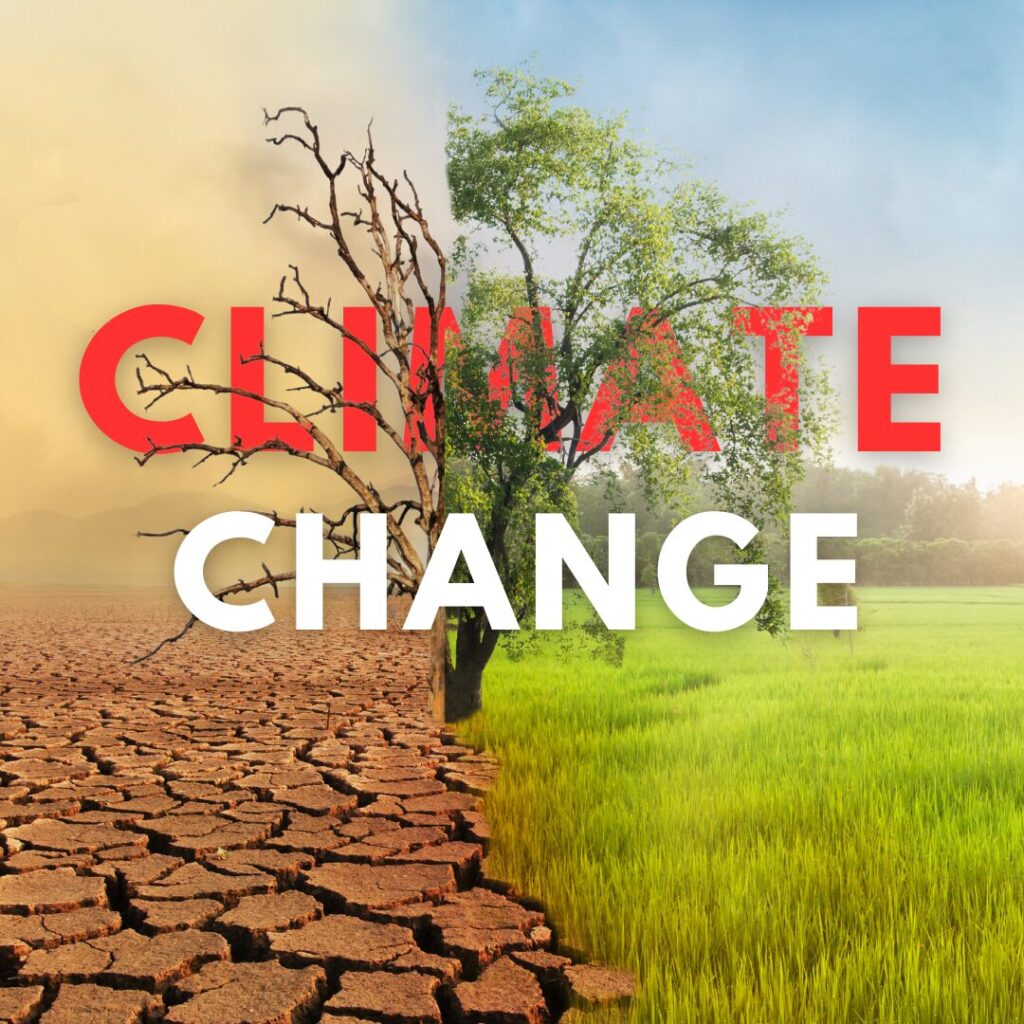Climate change is one of the most pressing global challenges of our time, and India is at the forefront of its impacts. This comprehensive article explores the alarming effects of climate change in India and presents effective solutions to address this crisis. From rising temperatures and extreme weather events to water scarcity and biodiversity loss, the consequences of climate change are far-reaching and demand immediate action. The article delves into the underlying causes of climate change, such as fossil fuel combustion and deforestation, and examines India’s national initiatives to combat this global threat. It also highlights the importance of renewable energy, sustainable development, and climate adaptation strategies to build a more resilient and eco-friendly future for the country. By raising awareness and promoting individual and community involvement, this article aims to empower readers to play a crucial role in mitigating and adapting to the impacts of climate change in India.
Key Takeaways
- Climate change poses significant threats to India, including rising temperatures, extreme weather events, water scarcity, and biodiversity loss.
- The main drivers of climate change in India are fossil fuel combustion and deforestation, which contribute to greenhouse gas emissions.
- India’s National Action Plan on Climate Change outlines key initiatives to promote sustainable development and climate resilience.
- Renewable energy sources, such as solar and wind power, as well as sustainable practices, are crucial for mitigating the effects of climate change.
- Individual and community involvement, through lifestyle changes and local initiatives, can play a vital role in addressing the climate crisis in India.
Understanding Climate Change in India
Climate change is a complex phenomenon that is transforming the world we live in, and India is at the forefront of this global challenge. To fully comprehend the gravity of the situation, it is essential to understand the fundamental aspects of climate change and its underlying mechanisms.
What is Climate Change?
Climate change refers to the long-term shifts in weather patterns and average temperatures across the globe, driven by both human activities and natural processes. These changes are primarily attributed to the increased concentration of greenhouse gases, such as carbon dioxide and methane, in the Earth’s atmosphere. These gases trap heat, leading to a gradual rise in global temperatures, a phenomenon known as global warming.
Global Warming and Greenhouse Gas Emissions
Global warming is the primary driver of climate change, and it is largely caused by the excessive emission of greenhouse gases, primarily from human activities. The burning of fossil fuels for energy production, transportation, and industrial processes releases large amounts of carbon dioxide and other greenhouse gases into the atmosphere. Additionally, deforestation and land-use changes contribute to the imbalance in the Earth’s natural carbon cycle, further exacerbating the problem of global warming.
By understanding the fundamental aspects of climate change, such as the role of greenhouse gas emissions and the phenomenon of global warming, readers in India can gain a deeper appreciation for the gravity of this issue and the urgent need for collective action to address it.
Climate Change Impacts in India
As the effects of climate change continue to unfold across the globe, India finds itself at the forefront of this global crisis. The country is witnessing a alarming rise in temperatures and an increasing frequency and intensity of heat waves, posing significant threats to human health, agricultural productivity, and overall societal well-being.
Rising Temperatures and Heat Waves
The average temperature in India has risen by approximately 0.7°C over the past century, and climate projections indicate that this trend is likely to continue. Heat waves, characterized by prolonged periods of extremely high temperatures, have become more common in recent years, with devastating consequences. These extreme heat events have claimed thousands of lives, particularly among the most vulnerable populations, such as the elderly, the poor, and outdoor workers. The impact on agriculture has been equally severe, with crop yields declining due to heat stress and water scarcity.
Extreme Weather Events
In addition to rising temperatures, India has also witnessed an increase in the frequency and intensity of extreme weather events, such as floods, droughts, and cyclones. Heavy rainfall and flooding have caused widespread destruction, displacing millions of people and disrupting critical infrastructure. Conversely, prolonged droughts have led to water shortages, livestock losses, and crop failures, exacerbating food insecurity and rural distress. The country has also experienced a rise in the number and severity of tropical cyclones, which have battered coastal regions, causing storm surges, coastal erosion, and substantial damage to life and property.
Coastal Erosion and Sea Level Rise
India’s vast coastline, home to millions of people, is under threat from the impacts of climate change. Rising sea levels, coupled with coastal erosion, are jeopardizing the livelihoods and safety of coastal communities. Saltwater intrusion into freshwater sources and the degradation of mangrove ecosystems have further compounded the challenges faced by these vulnerable regions. The increased frequency and intensity of cyclones have also taken a toll on coastal infrastructure, heightening the need for robust adaptation strategies to protect these vital regions.
By understanding the multifaceted impacts of climate change in India, readers will gain a deeper appreciation for the urgency of addressing this pressing issue. From the devastating effects of rising temperatures and extreme weather events to the threats posed by coastal erosion and sea level rise, the consequences of climate change are far-reaching and demand immediate action.
Causes of Climate Change in India
Climate change in India is a pressing issue that demands our immediate attention. At the heart of this challenge lies the complex interplay between human activities and the delicate balance of our environment. Two primary drivers of climate change in the Indian context are fossil fuel combustion and deforestation and land-use changes.
Fossil Fuel Combustion
India’s rapid economic growth and industrialization have led to a significant increase in the demand for energy, which has primarily been met through the burning of fossil fuels such as coal, oil, and natural gas. The combustion of these fuels for power generation, transportation, and industrial processes has resulted in the release of vast quantities of greenhouse gas emissions, particularly carbon dioxide, into the atmosphere. This accumulation of greenhouse gases traps heat and disrupts the Earth’s climate system, contributing to the overall climate change phenomenon observed in India.
Deforestation and Land-Use Changes
Another significant driver of climate change in India is the widespread deforestation and land-use changes occurring across the country. The conversion of forested areas into agricultural land, urban settlements, and other forms of development has significantly reduced the natural carbon sequestration capabilities of these ecosystems. Forests play a crucial role in absorbing and storing carbon dioxide, and their destruction disrupts this delicate balance, leading to an increase in greenhouse gas emissions and exacerbating the causes of climate change.
By understanding the root causes of climate change in India, policymakers, businesses, and individuals can work together to develop and implement effective mitigation strategies that address these fundamental issues. This will be crucial in building a more sustainable and resilient future for the country and its people.
Effects of Climate Change in India
As the impacts of climate change intensify across India, the nation is grappling with a myriad of pressing issues that threaten the well-being of its people and the environment. From the dire consequences of water scarcity and drought to the devastating impacts on food security and agriculture, the cascading effects of this global crisis are felt in every corner of the country.
Water Scarcity and Drought
The changing precipitation patterns and the depletion of groundwater resources have led to an alarming rise in water scarcity and prolonged droughts across India. Many regions, once abundant in water, now struggle to meet the basic needs of their communities, forcing residents to travel vast distances to access clean, potable water. This crisis not only disrupts daily life but also jeopardizes the sustainability of crucial industries, such as agriculture, which are the lifeblood of India’s economy.
Food Insecurity and Agriculture
The agricultural sector, which employs a significant portion of India’s workforce, has been hit hard by the impacts of climate change. Rising temperatures, erratic rainfall, and extreme weather events have caused severe disruptions to crop yields, leading to a growing crisis of food insecurity. Farmers, the backbone of India’s food production, are increasingly vulnerable to the ravages of drought, floods, and other climate-related disasters, threatening their livelihoods and the nation’s food supply.
Biodiversity Loss
The effects of climate change have also had a devastating impact on India’s rich biodiversity. Fragile ecosystems and endangered species are facing mounting pressures, as their habitats are disrupted by changing weather patterns and human-induced environmental degradation. The loss of biodiversity not only threatens the ecological balance but also undermines the delicate web of life that sustains communities across the country.
Human Health Impacts
The consequences of climate change extend beyond the environmental realm, directly impacting human health in India. The increased risk of vector-borne diseases, such as malaria and dengue, the exacerbation of respiratory issues due to air pollution, and the rise in heat-related illnesses pose significant challenges to the nation’s public health system. These growing health concerns not only burden the healthcare infrastructure but also compromise the well-being and productivity of the Indian populace.
As these multifaceted effects of climate change continue to unfold, it is imperative that India takes decisive action to mitigate and adapt to this global crisis. By addressing the root causes, implementing comprehensive adaptation strategies, and empowering individuals and communities, the country can work towards a more sustainable and resilient future, safeguarding the well-being of its people and the environment.
India’s National Action Plan on Climate Change
India’s commitment to addressing climate change is evident in its comprehensive National Action Plan on Climate Change (NAPCC). Launched in 2008, this pivotal initiative outlines eight key missions that aim to promote sustainable development and enhance the country’s resilience to the impacts of climate change.
National Missions and Initiatives
Under the NAPCC, India has implemented a range of targeted initiatives to address climate change across various sectors. The National Solar Mission, for instance, has set ambitious goals to expand the country’s solar power capacity, contributing to the nation’s transition towards clean energy. Similarly, the National Mission for Enhanced Energy Efficiency has driven initiatives to improve energy efficiency in industries, buildings, and transportation, ultimately reducing greenhouse gas emissions.
Additionally, the National Mission for Sustainable Habitat focuses on promoting sustainable urban development, including the adoption of energy-efficient building practices and the development of climate-resilient infrastructure. These efforts are complemented by India’s active engagement in international climate negotiations, where the country has demonstrated its commitment to the Paris Agreement and the United Nations Sustainable Development Goals.
By spearheading these national-level missions and initiatives, India is asserting its leadership in the global fight against climate change. The country’s proactive approach to addressing the climate crisis serves as a testament to its unwavering determination to build a more sustainable and resilient future for its people and the planet.
Renewable Energy and Sustainable Development
As India grapples with the pressing challenges of climate change, the country has emerged as a global leader in the transition towards renewable energy and sustainable development. This strategic shift holds immense promise in mitigating the adverse effects of global warming and building a more resilient, eco-friendly future for the nation.
Solar Power
At the forefront of India’s renewable energy revolution is the ambitious solar power initiative. The country has set an impressive target of achieving 100 GW of solar capacity by 2022, a testament to its unwavering commitment to clean energy. Spearheaded by the National Solar Mission, India’s solar power sector has witnessed exponential growth, with solar installations soaring across the country. From large-scale solar parks to decentralized rooftop systems, this renewable energy source is transforming the nation’s energy landscape and reducing its reliance on fossil fuels.
Wind Energy
Complementing the solar power revolution, India’s wind energy sector has also emerged as a global leader. The country is currently one of the world’s top wind power producers, with a rapidly expanding wind power capacity. Investments in cutting-edge wind turbine technology, coupled with strategic policy initiatives, have propelled the growth of this renewable energy source. By harnessing the abundant wind resources across the nation, India is diversifying its energy mix and making strides towards a sustainable future.
Biofuels and Biomass
Beyond solar and wind, India is also exploring the potential of biofuels and biomass as alternative energy sources. The country’s biofuel program, which aims to blend ethanol and biodiesel with conventional fuels, holds promise in reducing the carbon footprint of the transportation sector. Additionally, the utilization of biomass, such as agricultural waste and forestry residues, for energy generation is gaining traction, offering a sustainable solution to India’s energy needs. These innovative approaches demonstrate the nation’s holistic strategy to transition towards renewable energy and combat the effects of climate change.
By embracing these renewable energy solutions and promoting sustainable development, India is positioning itself as a global model for climate action. The country’s steadfast commitment to clean energy and eco-friendly practices not only addresses the pressing environmental concerns but also fosters economic growth and social well-being, paving the way for a more resilient and prosperous future.
Climate Change Adaptation Strategies
As India grapples with the escalating impacts of climate change, the country has prioritized the development and implementation of robust adaptation strategies to build resilience and safeguard its people, resources, and infrastructure. These strategic interventions span various sectors, each playing a crucial role in fortifying the nation’s capacity to withstand and recover from the adverse effects of climate change.
Water Resource Management
Recognizing the critical importance of water security, India has introduced a multifaceted approach to water resource management in the face of climate change. This includes initiatives to conserve and efficiently utilize water, develop sustainable irrigation practices, and protect groundwater resources. By implementing innovative technologies, promoting water-saving agricultural techniques, and strengthening infrastructure for water storage and distribution, India aims to ensure the availability and equitable access to this precious resource, even in the face of changing precipitation patterns and increasing water scarcity.
Disaster Risk Reduction
Climate change has heightened the frequency and intensity of extreme weather events, posing significant threats to communities across India. The country’s disaster risk reduction strategies focus on enhancing early warning systems, improving infrastructure resilience, and empowering local communities to be better prepared for disasters. Through the development of robust emergency response mechanisms, the implementation of risk-informed land-use planning, and the promotion of community-based disaster preparedness programs, India is working to mitigate the impacts of climate-related disasters and safeguard the lives and livelihoods of its citizens.
Climate-Resilient Agriculture
Given the central role of agriculture in India’s economy and the livelihoods of millions, the country has placed a strong emphasis on developing climate-resilient agricultural practices. This includes the adoption of drought-resistant crop varieties, the implementation of sustainable farming techniques such as precision agriculture and agroforestry, and the diversification of livelihood options for farmers. By equipping the agricultural sector with the necessary tools and knowledge to adapt to changing climatic conditions, India aims to ensure food security, protect the livelihoods of rural communities, and promote the long-term sustainability of its agricultural system.
Individual and Community Involvement
As we’ve explored the alarming impacts of climate change in India, it’s evident that addressing this global crisis requires a multifaceted approach. While government initiatives and policies play a crucial role, the active participation of individuals and communities is essential in driving lasting change. Each of us has the power to make a tangible difference in the fight against climate change.
One of the most impactful steps we can take is to reduce our carbon footprint through conscious lifestyle changes. This can include simple yet effective measures, such as practicing energy conservation by adopting energy-efficient appliances, switching to renewable energy sources, and implementing sustainable habits like turning off lights and electronics when not in use. Additionally, opting for sustainable transportation options, such as walking, cycling, or using public transit, can significantly lower our environmental impact.
Beyond individual actions, we can also get involved in community-level initiatives that contribute to climate change mitigation and adaptation. Participating in tree-planting campaigns, recycling drives, and local advocacy efforts can foster a sense of collective responsibility and drive meaningful change within our communities. By coming together and advocating for sustainable policies and practices, we can amplify our voices and inspire others to join the movement.
By empowering individuals and communities to take action, we can create a ripple effect that ultimately contributes to a more sustainable and resilient future for India. The time to act is now, and each of us has a crucial role to play in addressing the pressing challenge of climate change. Let us rise to the occasion and become active participants in shaping a greener, more climate-conscious India.
FAQ
What is climate change?
Climate change refers to the long-term shifts in weather patterns and average temperatures across the globe, driven by human activities and natural processes. It encompasses the phenomenon of global warming, which is the rise in Earth’s surface temperature due to the increased levels of greenhouse gas emissions.
What are the main causes of climate change in India?
The primary drivers of climate change in India are the combustion of fossil fuels, such as coal, oil, and natural gas, for energy production, transportation, and industrial activities, as well as deforestation and land-use changes that disrupt the natural carbon sequestration process.
What are the effects of climate change in India?
The effects of climate change in India include rising temperatures and the increasing frequency and intensity of heat waves, water scarcity and drought, food insecurity and disruptions to agricultural productivity, biodiversity loss, and various human health impacts, such as the spread of vector-borne diseases.
How is India addressing climate change?
India has launched its National Action Plan on Climate Change, which outlines eight key missions to promote sustainable development and climate resilience. These include initiatives focused on renewable energy, energy efficiency, sustainable habitat, and climate adaptation strategies, such as water resource management and disaster risk reduction.
What is the role of renewable energy in India’s climate change mitigation efforts?
Renewable energy sources, such as solar power, wind energy, and biofuels, play a crucial role in India’s efforts to reduce greenhouse gas emissions and transition towards a low-carbon, sustainable economy. The country has set ambitious targets for renewable energy expansion, including the goal of achieving 100 GW of solar capacity by 2022.
How can individuals and communities contribute to addressing climate change in India?
Individuals can contribute by reducing their carbon footprint through lifestyle changes, such as energy conservation, sustainable transportation choices, and responsible waste management. Communities can also get involved in initiatives like tree-planting campaigns, recycling drives, and local advocacy efforts to drive collective action and promote environmental awareness.




